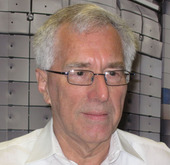ADAS-EU Personnel
Electron Working Party
Nigel Badnell- Gives advice on electron data
- Gives guidance to sub-contractors
ADAS-EU Managers
Martin O'Mullane- Reports to Director
- Responsible for management of research fellows
- Responsible for management of research fellows
ADAS-EU Sub-contractors
Univ. GroningenUniv. Autónoma Madrid
Univ. Mons-Hainaut
Univ. Giessen
Univ. Wien
Univ. Vilnius
Queen's University, Belfast
- Report to ADAS-EU Managers
- Takes advice from Special Advisor
- Takes advice from Electron Working Party
- Takes advice from Electron Working Party
ADAS-EU Research Fellows
Francisco GuzmánLuis Fernández Menchero
Alessandra Giunta
- Report to ADAS-EU Managers
- Report to ADAS-EU Managers
Hugh Summers

Professor of Theoretical Atomic Physics, University of Strathclyde; Fellow of the Royal Astronomical Society; Fellow of the Institute of Physics; Seconded to JET Joint Undertaking to oversee provision of all aspects of atomic physics (1984 — 94); Consultant to UKAEA Culham/EFDA-JET Facility (1994 — present); Consultant to IAEA Vienna (2001); Initiator and Director of the ADAS Project (1987 — present). His research is in theoretical atomic collision physics and the associated radiating characteristics of atoms in plasmas. He has special interest in the diagnostic analysis of laboratory and astrophysical plasmas and works closely with experimental spectroscopists and plasma analysts in laboratories throughout the world.
Martin O'Mullane

Senior Research Fellow, University of Strathclyde; seconded full-time to UKAEA Culham Science Centre supporting the EFDA-JET and MAST experiments; ADAS advisor and consultant to JET Task Forces, MAST team and other EFDA participants ; Initiator of specialist diagnostic development proposals for the JET Facility as part of the EU Close Support Programme plan; scientific coordinator; associate proposer on UKAEA study initiatives for ITER: ADAS developer. Dr. O'Mullane is a theoretical atomic physicist with expertise in atomic processes in plasmas. He has focussed on impurity species (both light and heavy), their diffusive transport and spectral emission in tokamak plasmas. He develops and maintains the primary computational radial transport codes at JET and their interface to atomic physics data. He oversees the chain of experimental data reduction at JET. He is a main developer of the ADAS capabilities which now underpin most diagnostic analysis of spectrometer data.
Nigel Badnell

Professor of Physics, University of Strathclyde. A computational atomic physics theorist, who has coordinated colleagues throughout the world (especially in the USA) in large scale production of electron impact data for fusion (according to ADAS specification) including dielectronic recombination, radiative recombination, electron impact ionisation and electron impact excitation. Professor Badnell will continue to lead and engage in these international activities, such as APAP, the Opacity Project and the Iron Project, and pursue the development of new front-line methodologies for electron impact.
Ratko Janev

Director of the Theoretical Department of the Institute of Physics (Belgrade) (1980 - 1982); special adviser of the Yugoslav Federal Sub-Commission for Nuclear Energy (on nuclear fusion matters (1984 - 1987); Member of the Macedonian Academy of Sciences and Arts; consultant of the Princeton Plasma Physics Laboratory and Oak Ridge National Laboratory (1983 - 1987); Director of the activities of IAEA (Vienna, Austria) (1987 - 1999) in the field of atomic and molecular data for fusion, including many international collaboration projects for generation, compilation and critical assessment of atomic and plasma-wall interaction data for fusion; initiated the the IAEA "green book" series "Atomic and plasma-material interaction data for fusion"; Initiated (with Prof. A. Dalgarno, Harvard University, USA) the biannual "International Conference on Atomic and Molecular Data and Their Applications" and acted as Chair of its Program Committee (1998 - 2004). Professor Janev has authored six books and has more than 200 research publications. Professor Janev's research interests lie in the field of theoretical atomic physics, including electron-atom/molecule and ion-atom collisions, particle-surface interactions and collision processes in plasmas.
Francisco Guzmán

Research Fellow, University of Strathclyde; seconded full-time to FZ-Jülich. Dr. Francisco Guzmán defended his thesis on Collisional Processes between Multicharged Ions and Neutral Atoms for Plasma Diagnostic at Different Temperatures at TJ-II in Universidad Complutense de Madrid in November of 2008. There he studied atomic physics ion/atom collisions and developed a diagnostic model for ionic temperature in the outer plasma of TJ-II. He comes from theoretical atomic physics (ion/atom collisions) and has interest in the atomic and molecular processes in the plasma edge and divertor.
Luis Fernández Menchero

Research Fellow, University of Strathclyde; seconded full-time to the Max-Planck-Institut für Plasmaphysik, Garching. Dr. Luis Fernández Menchero defended his PhD thesis on ion-molecule collisions at low impact energies in September 2005 in Universidad Autónoma de Madrid. He has held post-doc positions at TU-Clausthal, Germany (2006 - 2009) on laser-molecule interaction, and Universidad Nacional del Sur, Argentina (2009) on ion-molecule collisions at intermediate energies. He comes from the field of theoretical atomic physic and has interests in ionic, atomic and molecular collision processes which are valuable for plasma modeling.
Alessandra Giunta

Research Fellow, University of Strathclyde; seconded part-time to Culham Centre for Fusion Energy for ADAS-EU and part-time to Space Science, Rutherford Appleton Laboratory, UK. Alessandra defended her thesis on 'Spectral analysis of the solar atmosphere at the chromosphere-corona boundary' in 2011. She has special experience in generalised collisional-radiative theory, differential emission measure analysis and spectral diagnostics, and of spectral observations from spacecraft. Current interests are in dynamical solar astrophysical and fusion plasmas.


